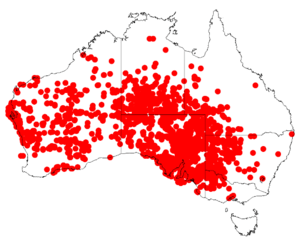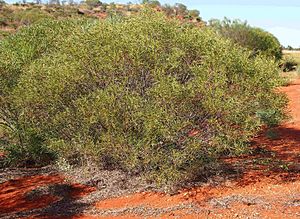Foliage web spider facts for kids
Quick facts for kids Foliage web spider |
|
|---|---|
| Scientific classification | |
| Genus: |
Phryganoporus
|
| Species: |
candidus
|
 |
|
The Phryganoporus candidus, also called the foliage web spider, is a small spider found only in Australia. These spiders are known for living in groups when they are young. They are usually 6 to 10 millimeters long.
Foliage web spiders are a mix of brown colors and have shiny, silvery-grey hair all over their bodies. They like to live in dry and partly dry areas. You can find their nests in trees, bushes, and other plants. They especially like to build their homes in Acacia ligulata trees because they have a special helpful relationship with them.
When a female foliage web spider is going to have babies, she builds a nest. Her young spiders will live, hunt, and grow up in this nest. These nests are like mazes with many tunnels. These tunnels help keep enemies away and also trap insects for the spiders to eat.
Contents
- What Do Foliage Web Spiders Look Like?
- Where Do Foliage Web Spiders Live?
- What Do Foliage Web Spiders Eat?
- How Do Foliage Web Spiders Build Their Nests?
- Who Are the Predators of Foliage Web Spiders?
- Reproduction and Life Cycle
- Spider Behavior
- A Helpful Relationship with Trees
- How Foliage Web Spiders See
- Interactions with People
- Spider Venom
What Do Foliage Web Spiders Look Like?
The foliage web spider is a small spider. Both male and female spiders are usually about 6 to 10 millimeters long. Their bodies are mostly brown, with lighter brown patterns.
These spiders are covered in fine, silvery-grey hair. How much hair they have can be different for each spider. Female spiders have round parts called spermathecal lobes. Male spiders have special leg-like parts called palps that help identify them.
Where Do Foliage Web Spiders Live?
Foliage web spiders live all over mainland Australia. They usually prefer dry and partly dry places. They like to build their nests in open forests, open scrub, or open woodlands.
Since they have a helpful relationship with Acacia ligulata trees, they often build their nests there. However, they can also build nests in other types of trees and plants.
What Do Foliage Web Spiders Eat?
Foliage web spiders eat many different kinds of insects and other small creatures. This includes beetles, cockroaches, and lady bugs. They are not picky eaters and will usually eat whatever gets caught in their webs. They even eat other spiders that try to get their eggs!
Most of their feeding happens in the evening after they fix their nests. Interestingly, mealybugs often scavenge in their nests but are never eaten. This might be because mealybugs have a waxy coating and special defense liquids.
How Do Foliage Web Spiders Build Their Nests?
Foliage web spider nests are very complex. They are made from leaves, twigs, and other bits of nature, all held together with spider silk. A single pregnant female spider starts building the nest in late summer. The nest is like a maze of tunnels that helps trap prey.
While building, the mother spider puts special scents, called pheromones, into the nest. These scents help her babies work together and reduce fighting. By the end of summer, a nest can have about 100 young spiders living in it.
These nests are usually about 0.02 cubic meters in size. Prey gets caught and eaten in the middle of the nest. Other small creatures, like other arthropods, also live in these nests. Some are predators, and some are scavengers. For example, simaetha sp spiders live on the edge of the nests. They eat insects stuck on the outside without getting caught in the web themselves.
Who Are the Predators of Foliage Web Spiders?
Many animals hunt foliage web spiders. Inside the nest, predators like crickets, ground spiders, sac spiders, and huntsman spiders hunt adult spiders.
Outside the nest, birds like the Black-faced cuckooshrike and spangled drongo eat them. However, these birds hunt during the day, and foliage web spiders are active at night, so they are less often in danger from these birds.
The eggs of foliage web spiders are also at risk. Pentatomidae (stink bugs) and mantid lacewings try to get into nests to eat the eggs. Oecophorid (moth) eggs can also parasitize the spider eggs.
Reproduction and Life Cycle
Young female spiders leave their birth nest just before they become adults. Male spiders wait until they are fully grown before leaving. This helps prevent spiders from mating with their close family members and helps new genes spread between nests.
Males are ready to mate when their palps are fully grown. Females are ready when a part of their body called the epigyne is fully developed. After mating, not all females will produce egg sacs. If they do, the egg sacs are covered in silk and placed safely in the mother's new nest.
An egg sac can hold different numbers of baby spiders, but on average, there are about 25 spiderlings per sac in the wild. A mother spider will lay a few sacs, and the baby spiders usually start to hatch around April.
Spider Behavior
Social Behavior
Foliage web spiders are considered "subsocial." This means they only work together when they are young. This cooperation happens because of the special scents their mother puts in the nest. They are social during their young life and, for females, when they are mothers.
Young female spiders, even if they are not related, will work together to catch prey. However, if two female spiders are looking for a place to build a nest, or two male spiders are too close, they will fight to reduce competition.
Mating and Courtship
When a male spider wants to mate, he approaches a female and starts tapping his palps. If the female is interested, she will tap back. They might touch each other's front legs or even nip each other gently.
After this first contact, one of two things will happen. If the female doesn't want to mate, there might be a standoff. The male might try to keep courting, or he will run away to avoid being attacked. If the female is willing to mate, they will get into their mating positions. They face different directions, and the male moves around the female as he climbs on her.
One unique thing about these spiders is that males do not "charge" their palps during courtship or mating. It's thought they do this before they even approach a female. Mating rituals can last from two to six hours and usually involve multiple mating sessions. After mating, the male leaves the female. Sometimes, the female might eat the male, but this is not common. Females will mate with more than one male.
Parental Care
A mother's care is very important for the survival of young foliage web spiders, especially when they are developing in the egg sac. Baby spiders without a mother are nine times more likely to die than those cared for by their mother.
Mothers do not directly feed their young. However, they sometimes let their babies eat from the body of prey she has caught. Mothers also release special scents into their web while building it. This helps their babies cooperate when they live together. Female spiders only raise their own babies; they do not help raise other females' babies.
Hunting
Because they are subsocial, young foliage web spiders will hunt and catch prey in groups. When hunting together, the spider closest to the prey will attack first, and the others will follow. Adult spiders do not hunt in groups, but mothers sometimes share their catch with their young.
Foliage web spiders mostly hunt prey caught in their nests. They usually do not kill prey during the day because they are more likely to be hunted themselves during daylight hours. Larger spiders are more likely to attack prey than smaller ones, probably because their size makes it safer for them. Also, young adult females are more likely to attack prey than young adult males.
A Helpful Relationship with Trees
The foliage web spider has a helpful relationship with the Acacia ligulata tree. This tree is a flowering plant found widely across Australia. It flowers in September, grows its fruit over the next few months, and then releases its seeds in late summer.
Foliage web spider nests often cover the fruit on Acacia ligulata trees. This helps the trees because the spider nests protect the fruit from being eaten by pests. One study found that trees with spider nests had between 20% and 406% more seeds than trees without nests. Researchers also saw less pest damage on trees with spiders. For example, damage from weevils was reduced by 54% to 95%.
Foliage web spiders that build their nests in living Acacia ligulata trees have larger nests. Their nests also last longer than those built in other tree types. Spiders nesting in Acacia ligulata trees also catch more prey and get better nutrients.
Since both the spiders and the trees help protect each other, their relationship is called "protection mutualism."
How Foliage Web Spiders See
Foliage web spiders have eight eyes. They have one larger main pair and three smaller pairs. The way their eyes are placed helps them see prey both to the side and straight ahead. Their main pair of eyes can see more than 30 body lengths in front of them. This helps them spot potential mates, rivals, and predators. Foliage web spiders can tell what a creature is based on its shape and how it moves.
Interactions with People
While generally not a big problem, foliage web spiders can sometimes bother farmers and people who grow fruit. They have complained that the spiders' webs can mat up leaves, cause leaves to fall, and damage tree branches. Foliage web spiders can also be a problem for farm animals. Livestock might not be able to eat plants that are covered in spider webs.
Spider Venom
The foliage web spider uses its venom to catch its prey. It releases the venom through its fangs, called chelicerae. After catching prey, the spider wraps it in silk while it is paralyzed, saving it for later.
However, the venom is not dangerous to humans. There have been no known cases of people being bitten by this spider. The reason it can paralyze small prey but not harm humans is likely because the amount of venom is very small. It is only enough to affect tiny creatures.



